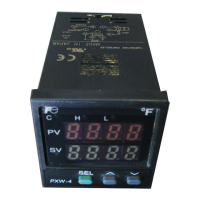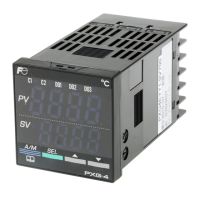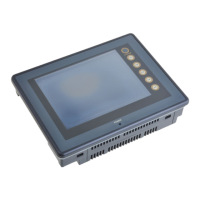15
P-AH Alarm Type 1:
P-AL Alarm Type 2: These functions set the control action
for
the optional alarm output relays. They can be pro-
grammed for absolute, deviation, combination, or zone
alarm configuration. The high and low alarm setpoints
are set with primary menu parameters AH and AL (AL
is not applicable in the case of PXV3). The absolute
alarm configurations are independent of main setpoint.
The alarm output relays are energized when the
process variable exceeds the alarm setpoint, an
absolute value. The deviation alarm configuration is
main setpoint tracking. The alarm output relays are
energized when the process variable exceeds the
main setpoint by a deviation value set by AL or AH.
The combination alarm configurations are a mixture of
both the deviation and absolute value settings for the
high and low alarms. With zone alarm configurations
the alarm output is energized between the range set
by AL and AH.
One of the alarm types is Alarm with Hold. In this case
the alarm is not turned on the first time the measured
value is in the alarm band. Instead it turns on only
when the measured value goes out of the band and
enters it again. This type is useful when using devia-
tion alarm with step type input.
Enter the code for P-AH and P-AL from the Table of Alarm
Action Type Codes. See Figues below.
P-AL is not applicable in the case of PXV3.
Note 1: A change of alarm action type can cause the
alarm set value to change, but this is not a malfunction.
Note 2: After the alarm type is changed, turn off the
power to the unit once.
PVOF Process Variable Offset: The Process variable Offset
is the amount by which the indicated process variable
is shifted in a positive or negative direction. Both the
indicated as well as the measured process variable
will be changed. This parameter can be used to cor-
rect for differences in sensors, sensor placement, and
standardization problems. Enter a value which is the
difference between the measured process value and
the actual process value of the system.
Setting range: -10 – 10% of full scale, set in Eng. units.
SVOF Setpoint Variable Offset: The Setpoint Variable Offset
is that amount of offset which shifts the measured set-
point variable in a positive or negative direction. The
measured setpoint variable is changed but the indicat-
ed setpoint variable remains unchanged. Be careful
when using this variable because what you see as the
setpoint variable may be very different from the actual
setpoint variable.
Setting range: -50 – 50% of full scale, set in Eng. units.
Indicated Setpoint Variable is Unchanged
Measured Setpoint Variable is Changed
P-F C/F Selection: The C/F Selection allows choosing
either the Celsius or the Fahrenheit scale. If using the
controller to control a process other than temperature
using the current/voltage input model, the C/F
Selection is not important because the scaling is done
using the lower limit of the input range and upper limit
of input range parameters. If using the
thermocouple/RTD (Pt100) input model, however, the
C/F Selection is important in scaling the controller’s
parameters.
Setting: °C or °F

